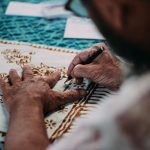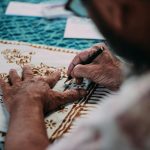Yes, batik fabrics can shrink, especially if they’re made from natural fibers like cotton or silk, which absorb water and contract when exposed to heat. Hot water, high dryer temperatures, and harsh washing can all cause this shrinkage. You’ll want to avoid hot washing, choose gentle detergents, and air dry batik to keep its shape and vibrant colors intact. Keep going to discover how fiber types, wax, and washing methods impact your batik’s lifespan.
Table of Contents
Key Takeaways
- Batik fabrics made from natural fibers like cotton and silk are prone to shrinking, especially if exposed to hot water or high heat.
- Shrinkage is influenced by fiber composition, with cotton shrinking more than silk or rayon, while polyester resists shrinking.
- Hot water, high dryer heat, and agitation during washing increase the likelihood of batik fabric shrinkage.
- Wax and dye application can affect fabric tension, potentially causing uneven shrinkage if wax cracks or melts.
- To minimize shrinkage, batik fabrics should be hand washed in cold or lukewarm water with mild detergent and air-dried in shade.
Understanding Batik Fabric Composition
Batik fabric combines art and material, blending cotton, silk, or rayon fibers with wax-resist dyeing techniques. When you choose a batik piece, understanding its fiber content is essential because it affects how the fabric behaves, especially when exposed to water or heat.
Cotton batik is breathable and durable but may shrink if not cared for properly. Silk batik feels luxurious and drapes beautifully, yet it requires gentle handling to maintain its integrity. Rayon batik offers a smooth finish but tends to be more delicate.
Knowing these differences helps you anticipate how the fabric will react during washing or ironing. By grasping the composition, you can better care for your batik fabric and preserve its vivid designs and texture over time.
Factors Influencing Batik Fabric Shrinkage
Although fabric shrinkage can be frustrating, understanding the factors that cause it helps you prevent unwanted changes in your batik pieces.
Temperature plays a big role—hot water or high dryer heat can make fibers contract. The way your batik fabric was treated during manufacturing also matters; if it wasn’t pre-shrunk, it’s more likely to shrink later.
Agitation during washing can cause fibers to tighten and pull together, leading to shrinkage. Additionally, the fabric’s weave density affects shrinkage—you’ll notice tighter weaves resist shrinking better than loose ones.
Finally, drying methods impact shrinkage; air drying is gentler, while machine drying can intensify fiber contraction. Knowing these factors helps you care for your batik fabric properly and keep its size intact.
How Different Fibers in Batik React to Washing
When you wash batik fabrics, the type of fiber they contain greatly affects how they respond to water and agitation.
Natural fibers like cotton and silk tend to shrink more because their fibers absorb water and swell. Synthetic fibers, on the other hand, resist shrinking but might react differently to heat.
Natural fibers absorb water and swell, causing shrinkage, while synthetics resist shrinking but may react to heat.
Here’s what you should keep in mind about different fibers:
- Cotton shrinks considerably, especially if washed in hot water.
- Silk can shrink and lose its sheen if not handled gently.
- Rayon behaves like natural fibers but is more delicate.
- Polyester resists shrinkage but may retain odors or stains.
- Blends combine characteristics, so follow care instructions carefully.
Understanding the fiber content helps you choose the right washing method to prevent unwanted shrinkage.
The Role of Dye and Wax in Batik Shrinkage
Since dye and wax play essential roles in creating batik’s distinctive patterns, they also influence how the fabric behaves during washing.
When the wax melts or cracks, it can expose untreated fabric areas, leading to uneven dye absorption and potential shrinking. The dye itself, often made from natural or synthetic sources, can affect the fabric’s fibers differently. If the dye penetrates deeply, it may stabilize the fabric, reducing shrinkage. However, surface-level dyes might leave fibers more vulnerable.
Wax acts as a protective barrier, but if it’s not applied evenly or removed properly, it can cause fabric tension changes, impacting shrinkage.
Optimal Washing Techniques for Batik Fabrics
To preserve the vibrant patterns and prevent unwanted shrinkage, you need to wash batik fabrics carefully. Start by using cold or lukewarm water to avoid heat damage.
Carefully wash batik fabrics with cold or lukewarm water to preserve vibrant patterns and prevent shrinkage.
Always choose a mild detergent designed for delicate fabrics to protect the dye and wax. Hand washing is best, but if you use a machine, select a gentle cycle.
Avoid wringing or twisting the fabric, as this can distort the design and lead to shrinkage.
Remember these key points:
- Use cold or lukewarm water
- Select a mild detergent
- Hand wash or use gentle machine cycle
- Don’t wring or twist fabric
- Rinse thoroughly to remove all soap
Following these steps will keep your batik fabric vibrant and minimize shrinkage during washing.
Drying Methods That Prevent Batik Shrinkage
To keep your batik fabric from shrinking, you’ll want to air dry it instead of using heat.
Avoid exposing it to direct sunlight or high temperatures that can cause damage.
Laying the fabric flat while drying also helps maintain its shape and size.
Air Drying Benefits
Although machine drying might seem convenient, air drying your batik fabrics is the best way to prevent shrinkage and maintain their vibrant patterns.
When you air dry, you allow the fabric fibers to relax naturally, reducing the risk of tightening and shrinking. Plus, air drying helps preserve the delicate wax-resist dye work that defines batik.
Here’s why air drying works well for your batik:
- Prevents excessive heat exposure that causes fabric contraction
- Maintains color brightness and pattern integrity
- Reduces fabric stress and distortion
- Extends the lifespan of your batik garments
- Costs no energy, making it eco-friendly
Avoiding Heat Exposure
When you steer clear of high heat during drying, you greatly cut down the chances of your batik fabric shrinking. Heat causes fibers to contract, so avoiding dryers or hot sunlight is key. Instead, opt for gentle drying methods that preserve your fabric’s size and vibrancy.
Here’s a quick guide to drying choices:
| Drying Method | Effect on Batik Fabric |
|---|---|
| Tumble Dry (High Heat) | High risk of shrinkage |
| Shade Air Dry | Minimal shrinkage, safest |
| Direct Sunlight Drying | Can fade colors, slight shrink |
Flat Drying Techniques
Choosing the right drying method plays a big role in keeping your batik fabric from shrinking. Flat drying is one of the best techniques to maintain its shape and size. When you lay your batik flat, you avoid stretching or distorting the fabric, which often happens when hanging.
To flat dry effectively:
- Use a clean, dry towel or mesh drying rack
- Spread the fabric evenly without folds
- Avoid direct sunlight to prevent color fading
- Turn the fabric occasionally for even drying
- Keep it in a well-ventilated area to speed drying
Common Mistakes That Cause Batik to Shrink
You might be shrinking your batik without realizing it by washing it in hot water or using harsh detergents.
Skipping proper drying techniques can also cause your fabric to lose its shape.
Let’s look at these common mistakes so you can keep your batik looking its best.
Washing Temperature Errors
Although batik fabrics are prized for their vibrant patterns, improper washing temperatures can quickly ruin them by causing shrinkage.
You mightn’t realize that using water that’s too hot can damage the delicate fibers and cause the fabric to contract. To protect your batik, avoid these common temperature mistakes:
- Washing in water above 30°C (86°F)
- Using hot water for stain removal
- Inconsistent water temperatures during rinsing
- Ignoring care labels specifying cold wash only
- Frequent exposure to warm or hot water cycles
Stick to cold or lukewarm water to keep your batik’s size and color intact.
Improper Drying Techniques
Three common drying mistakes cause batik fabrics to shrink quickly.
First, you shouldn’t use high heat settings in your dryer. The intense heat breaks down fibers, making your batik fabric shrink and lose its vibrant patterns.
Second, avoid wringing out your batik fabric aggressively. Doing so distorts the cloth’s shape and stresses the fibers, leading to shrinkage.
Finally, don’t leave your batik fabric in direct sunlight for extended periods. Sunlight can weaken the fabric and cause uneven shrinking or fading.
Instead, air-dry your batik in a shaded, well-ventilated area, laying it flat or hanging it gently.
Using Harsh Detergents
Beyond drying techniques, the detergents you choose play a big role in maintaining your batik fabric’s size and quality.
Harsh detergents can strip the wax and dyes, weakening fibers and causing shrinkage. To protect your batik, avoid products that contain:
- Bleach or strong whitening agents
- Enzymes that break down fabric fibers
- High alkalinity formulas
- Fabric softeners with heavy chemicals
- Detergents with strong fragrances or dyes
Instead, opt for mild, pH-neutral detergents designed for delicate fabrics.
Always dilute the detergent before use and wash in cold water to minimize fiber stress.
Tips for Maintaining the Size and Shape of Batik Garments
When you want your batik garments to keep their original size and shape, proper care is essential.
Always wash them in cold water to prevent shrinkage and color bleeding. Use a mild detergent designed for delicate fabrics, avoiding harsh chemicals that can weaken fibers. Hand washing is preferable, but if you use a machine, select a gentle cycle.
After washing, avoid wringing your batik; instead, gently press out excess water. Dry your garments flat or hang them in the shade to prevent distortion and fading from direct sunlight.
Iron on low heat while the fabric is slightly damp to maintain its form. Following these steps will help your batik garments stay true to their size and shape, ensuring they look great wear after wear.
Frequently Asked Questions
Can Batik Fabrics Be Ironed Without Damaging the Design?
You know what they say, “Look before you leap.” You can iron batik fabrics, but use low heat and iron on the reverse side to protect the design. Don’t rush; gentle care preserves its beauty.
Are Batik Fabrics Suitable for Upholstery or Home Décor?
You can use batik fabrics for upholstery or home décor, but be mindful—they’re often lightweight and delicate. Consider lining or backing them for durability, so they hold up well and keep their vibrant, artistic appeal over time.
How Long Does Batik Fabric Typically Last With Proper Care?
Like a timeless story woven in threads, batik fabric can last decades if you care for it properly. By avoiding harsh washes and storing it well, you’ll keep its vibrant beauty alive for years.
Can Batik Patterns Fade Over Time With Exposure to Sunlight?
Yes, your batik patterns can fade if you expose them to sunlight for too long. To keep colors vibrant, try to store or display your fabric away from direct sunlight whenever possible.
Is It Safe to Use Bleach on Batik Fabrics?
You shouldn’t use bleach on batik fabrics because it can damage their colors and patterns. Instead, stick to gentle detergents and cold water to keep your batik looking vibrant and intact over time.
- Is Joann Fabrics Affected by China Tariffs? Exploring Impact - June 20, 2025
- Is Cotton Fabric From China Safe? Understanding Quality and Safety - June 20, 2025
- How to Sell Fabric Patterns to China: A Business Guide - June 20, 2025







